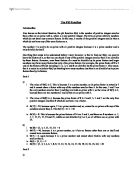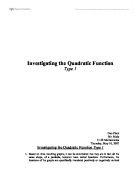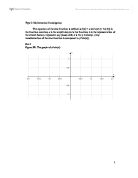- Φ(11) = 10, because again, 11 is a prime number and, so, cannot be co-prime with any of the numbers smaller than it. This Φ(11) = 11-1 =10
- Φ(24) = 8. This is because the prime factors of 24 are 2 and 3, and there are 8 numbers i.e. 1, 5, 7, 11, 13, 17, 19 and 23, which are not divisible by 2 or 3, so all of them are co-prime with 24.
- Φ(18) = {1, 5, 7, 11, 13, 17} = 6
- Φ(41) = 40, because it is a prime number, so it has no factors other than one or itself and cannot have common factors.
- Φ(7) = 6, again because it is a prime number and cannot share factors with any numbers smaller than it.
- Φ(6) = {1, 5} = 2
- Φ(25) = {1, 2, 3, 4, 6, 7, 8, 9, 11, 12, 13, 14, 16, 17, 18, 19, 21, 22, 23, 24} = 20
Part 2
- Φ(7 x 4) = Φ(28) = 12
Φ(7) x Φ(4) = 6 x 2 = 12
Thus, Φ(7 x 4) = Φ(7) x Φ(4)
- Φ(6 x 4) = Φ(24) = 8
Φ(6) x Φ(4) = 2 x 2 = 4
Therefore, Φ(6 x 4) ≠ Φ(6) x Φ(4)
- Check whether or not Φ(mn) = Φ(m) x Φ(n) for at least two separate choices of n and m
- Φ(5 x 10) = Φ(50) = 20
Φ(5) x Φ(10) = 4 x 4 = 16
Thus, Φ(5 x 10) ≠ Φ(5) x Φ(10)
- Φ(7 x 6) = Φ(42) = 12
Φ(5) x Φ(10) = 4 x 4 = 16
Therefore, Φ(5 x 10) ≠ Φ(5) x Φ(10)
-
In some cases, Φ(mn) = Φ(m) x Φ(n), whilst in other cases this is not so. Investigate this situation.
There are endless values of m and n which I can try, but it is not possible to investigate all of them, so instead, I will start with the smallest positive integers, and go up steadily to see if I can find a pattern or a link between m and n when Φ(mn) = Φ(m) x Φ(n).
Table showing values of Φ(mn) when m=1
Table showing values of Φ(mn) when m=2
Table showing values of Φ(mn) when m=2
Since, the tables above do not show any clear link or pattern between m and n, I have now made two tables comparing the values of m and n that do work for the equation Φ(mn) = Φ(m) x Φ(n) on the right, and the values that don’t on the left. Maybe this will help me spot a relationship between them.
At a first look, it seems that for all the values of m and n that do work, one number is even and the other odd. However, there are some exceptions, which show that this cannot be the case. For example, 1 and 3, 1 and 5, and 3 and 5 are all combinations of m and n which are both odd and yet they fulfil the equation Φ(mn) = Φ(m) x Φ(n).
Another possible relationship between m and n is that one cannot be a multiple of another. This is because all the values of n in the table on the right are divisible by m, while none of the values of n in the table on the left are divisible by m. However, when I carried out some further investigation to prove this theory, I found various larger combinations where n is not divisible by m, so according to my theory, they should fulfil the equation Φ(mn) = Φ(m) x Φ(n),but they do not. Some of them are listed below:
This means, that there is an even more general rule which defines the relationship between m and n. The two tables comparing values of m and n that fulfil or do not fulfil the equation have been placed below again, this time with some of the ‘anomalous’ pairs of m and n added.
Now, the only remaining connection between all the pairs that do not work is that m and n have common factors, or are not co-prime. All the pairs listed on the left that do work however, are ones where m is co-prime with n.
Thus I can conclude that Φ(mn) = Φ(m) x Φ(n), only when m and n are co-prime. The numbers must be co-prime to ensure that there are no repeated factors.
-
If p and q are prime numbers investigate Φ(pnqm)
Before I investigate this situation, there are a number of rules I have to establish. First of all, for any prime number p, Φ(p)= p-1, because it is only divisible by 1 and itself, and so, must be co-prime with all the numbers smaller than it. For example, Φ(3) = {1,2} = 2 (which is 3-1) and Φ(7) = {1,2,3,4,5,6} = 6 (which is 7 -1).
Next, if p is a prime number and pk is the power of that prime number, then Φ(pk) tells us the number of positive integers smaller than pk that are co-prime with it.
The prime factor of pk is p, so all the numbers which share common factors with pk must be multiples of p e.g. p, 2p, 3p ... and so on. Thus all the numbers which are not multiples of p, must be co-prime with pk. This means that, if the number of multiples of p smaller than then pk is m, then Φ(pk) = pk – m.
The value of m for any value of pk can be determined by. This can also be written as
pk-1, as is shown here:
In other words, m=, pk-1where m represents the number of multiples of p less than pk.
We know that pk-1 gives us m, which is the number of multiples of p smaller than then pk, because it represents the number of lots of p in pk. For example, 33 can also be written 3x3x3 which is 32 (9) lots of 3, so in other words, in 33 there are 33-1 or 32 multiples of 3.
Another thing we need to know, is the rule we learnt from Part 3, that Φ(xy) = Φ(x) x Φ(y), when x and y are co-prime. Applying this rule to Φ(pnqm) through substitution, if we say that x = pn and y = qm, then Φ(pnqm) = Φ(pn) x Φ(qm). The rule works because, as I explained earlier, the prime factors of pn and qm will be p and q respectively because they are both prime numbers, and so pn and qm will always be co-prime too, because they cannot have any common factors.
So we now know how to find Φ(pn) for any prime value of p by using the formula Φ(pn) = pn - pn-1 or Φ(qm) for any value of q using Φ(qm) = qm – qm-1. In this case, we must understand that n and m are used as constants instead of k, and that the meaning is one and the same. Using this information and the knowledge that Φ(pnqm) = Φ(pn) x Φ(qm), we can then find out Φ(pnqm) for any prime values of p and q.








